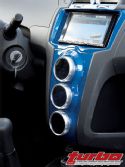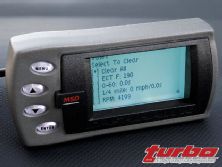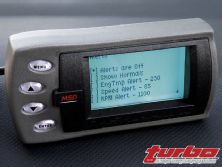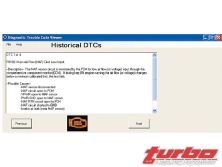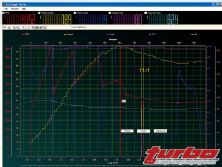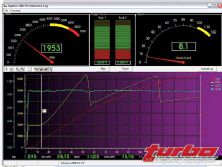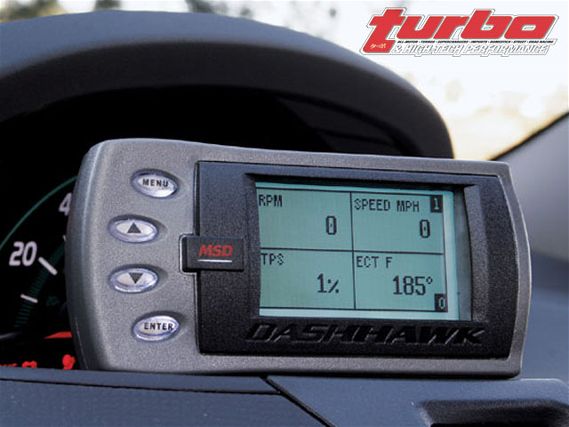 | The DashHawk has 11 different customizable displays that can be toggled between at any time. As many as seven parameters can be digitally displayed on the screen at once or two in bar graph form. The "1" in the top, right corner represents the display screen being viewed and the "O" in the bottom, right corner tells us we're in open loop mode.
| The DashHawk has 11 different customizable displays that can be toggled between at any time. As many as seven parameters can be digitally displayed on the screen at once or two in bar graph form. The "1" in the top, right corner represents the display screen being viewed and the "O" in the bottom, right corner tells us we're in open loop mode.
MSD DashhawkIf you enjoy challenging your car interior's space constraints with the number of gauges you can cram into your dashboard, MSD Ignition's DashHawk probably isn't for you. Or if you're content with the near-useless instrumentation your OEM provides you with, you likely won't be thrilled with what the DashHawk does. But if you're concerned with what your car's trying to tell you, and you want this information accurately without your interior resembling more like the inside of a submarine or jet cockpit and less like a Toyota, you should care about the latest DashHawk incarnation.
Most electronic devices nowadays claim to be multi-taskers. Most multitaskers can do lots of things but are never really great at just one of them. Not the case with the DashHawk. Other multi-taskers do important things, the things you bought them for, and also do a bunch of stupid things, things you really don't need or care about. Not the case with the DashHawk. The DashHawk has its share of features, but in the short time we used the small info display on Project Yaris we found nearly all of them useful.
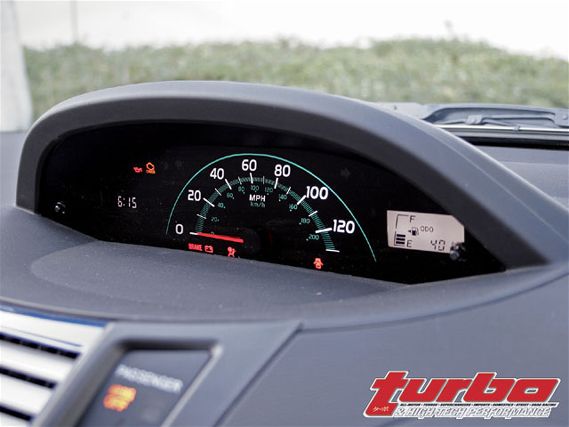 | The Yaris' interior is simple, as is its gauge cluster. The DashHawk lets us tap into information that Toyota won't let us, important stuff like water temperature and engine speed
| The Yaris' interior is simple, as is its gauge cluster. The DashHawk lets us tap into information that Toyota won't let us, important stuff like water temperature and engine speed
The DashHawk is many things: a real-time information display, a tuning device, an OBDII code scanner, even a performance meter. The DashHawk is limited to use on OBDII vehicles that feature CAN (controller area network). This narrows the field of vehicles compatible with the device since CAN hasn't made its way into all new OBDII cars yet. Luckily we have Project Yaris, the only OBDII CAN vehicle here at Turbo. If you aren't familiar with the Yaris' dashboard, its gauge cluster is fairly stark. A speedometer, fuel level indicator and clock are all Toyota deemed necessary for those driving the little hatchback. No water temperature or oil pressure gauges - just idiot lights that flash once damage has already occurred. The DashHawk works well here since it monitors vitals like water temperature, vehicle speed, engine speed, throttle position or really anything else the Yaris' ECM reads. We just plugged the DashHawk's supplied cable into the car's OBDII diagnostic port and it was up and running - no set up, no calibration required.
CAN is a relatively new on-board communications protocol used by almost all automakers. In short, CAN is an engineering standard, or a language, by which computers and modules communicate with one another within a vehicle. It's the most reliable and high-speed automotive communications protocol to date. By 2008, all new cars sold in the U.S. will have it. While the electronics and wiring inherent with CAN vehicles can be more complicated, diagnosing CAN vehicles for problems is easy. CAN vehicles provide more information, and faster, through the vehicle's diagnostic port in comparison to older OBDII cars. All that's needed to retrieve the information is a CAN-compliant code scanner. CAN-compliant scanners have hardware and software that take advantage of the faster communication rates. The DashHawk has all of this. Not sure if your vehicle is CAN-equipped? Finding out is easy, just locate the diagnostic port and see if pins 6 and 14 are occupied. If they are, your car has CAN.
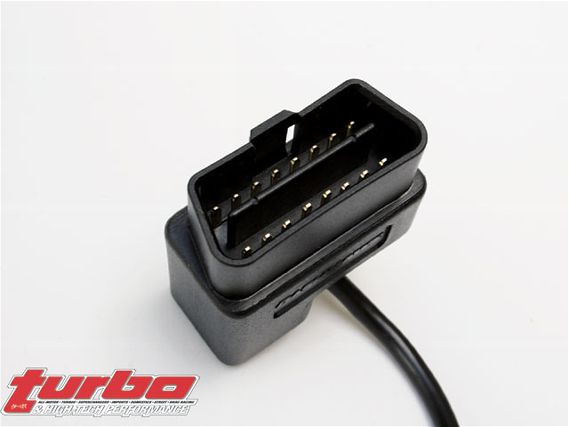 | The DashHawk only works on CAN-equipped OBDII vehicles. To determine whether or not your vehicle features CAN, locate the diagnostic port connector under the dash and check if pins 6 and 14 are occupied. If they are, you have CAN.
| The DashHawk only works on CAN-equipped OBDII vehicles. To determine whether or not your vehicle features CAN, locate the diagnostic port connector under the dash and check if pins 6 and 14 are occupied. If they are, you have CAN.
If you own an OBDII vehicle and work on it yourself, you need a code scanner. If your vehicle features CAN, be sure the scanner you pick up is CAN-compliant, like the DashHawk. Most people aren't going to drive around with a code scanner dangling off their diagnostic port, or even with one in their glove box. Most scanners are fairly bulky, not to mention expensive, and not the type of thing you want sliding around down by your feet while driving. Since the DashHawk is a multi-tasker, it makes sense to leave it plugged in all the time. And since it's small and dash-mountable, it will stay put. The DashHawk provides feedback that proves useful during varying driving conditions and can even read and clear trouble codes should one pop up. This can be especially useful when problems arise out on the road and the conventional code scanner would otherwise be back home in a drawer. The DashHawk recognizes most diagnostic trouble codes and is Internet updateable should new DTC's become available. As with any code scanner though, be sure and figure out why the code displayed in the first place instead of just clearing it and shrugging it off as a fluke.
Besides reading check engine lights, the DashHawk does other things that give it its multi-task status: on-board data logging, an audio/visual alarm, peak and hold functions and performance monitoring, like 0-60 mph and quarter-mile times with 60-foot and eighth-mile data included. Almost any of the 100 parameters the DashHawk reads can be uploaded to a PC - five at a time - with the supplied software. Runs can be viewed in graph form showing quarter-mile data and values for throttle position, manifold pressure, engine load, shift points or really anything else the ECM can tell it including DTC's. Even data you might not expect to be able to obtain like fuel trim banks, spark advance and intake air temperatures. The unit also interprets important information that lets users know if their vehicle is ready for an emissions test by monitoring EVAP system pressure, EGR valve error percentages and catalytic converter temperatures. The software also features a horsepower calculator and gear ratio calculator. Up to five minutes of any of this information can be recorded (about 90 seconds at a time, depending on sampling), uploaded and played back in real time. There's also a "valet" mode that records peak data for when the vehicle is loaned out. The DashHawk's audio/visual alarm can be used as either a warning device or to replace a more obtrusive shift light. The flashing multi-colored light and warning beep can be programmed to go off based on a variety of parameters like coolant temperature, engine speed or vehicle speed.
The DashHawk's display offers quite a bit of versatility. Users can toggle between 11 different screens, predefined by them, to keep tabs on dozens of vehicle parameters. If the ECM can read it, so can the DashHawk. The DashHawk is already scheduled to receive a slight revision. Version 2.1 will allow the unit to accept one additional sensor such as a wideband oxygen sensor or really anything else users should decide to plug in. Firmware updates like this can be made by going to MSD's website. Finally, a multi-tasker that makes sense.

